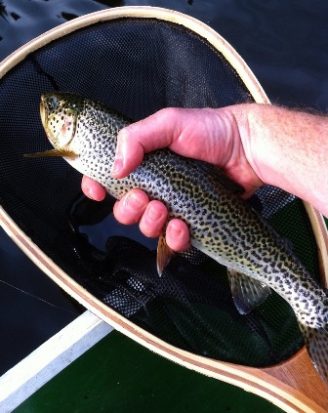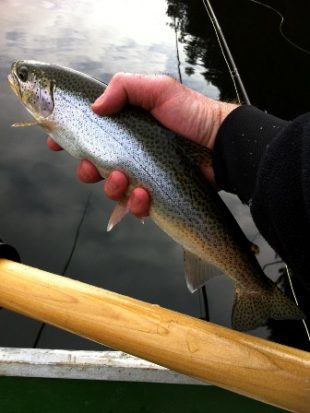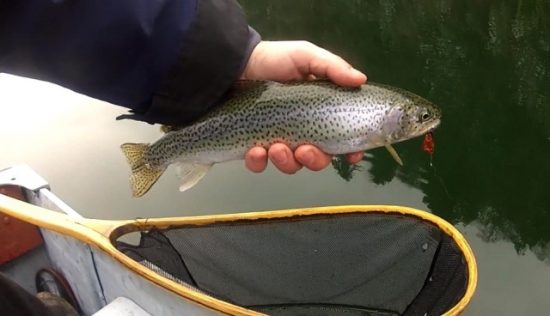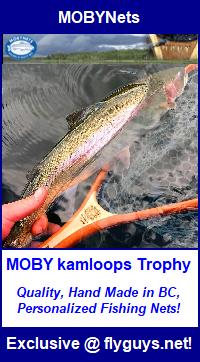[embedit snippet=”gas-ar-td-minimalist”]
Fly Fishing Cutthroat Trout
– Winter Strategies for Coastal Cutties –
The icy winds of November and December mean an end to the stillwater fly fishing season in most of our province, but in here in the Fraser Valley they signal the beginning of one of my favorite times of year. While many anglers target winter Steelhead on popular systems like the Chilliwack or Chehalis, I like to explore forgotten Fraser Valley sloughs and secluded backwaters in search of the elusive Coastal Cutthroat.
Fly Fishing Cutthroat Trout | General Characteristics …
 “Cutties,” as they affectionately called by many, are nomadic hunters, moving in schools throughout the waters of the southwest coast. Some are anadromous fish, spending most of their life in the coastal waters of the Salish Sea and returning to the Fraser system to spawn, and some are year-round residents of our local fresh waters. When you get to know them you can generally tell the two varieties apart, with the coastal fish often showing brilliant yellow tones and heavy spotting, and the resident fish usually bright chrome with anywhere from heavy to almost non-existent spotting. The variation in appearance from one fish to the next is truly amazing. In the areas that I fish, these fish tend to average about 12 inches and top out in the low 20s. My friend who works for DFO says that he’s measured fish moving through his counting fence that were in the 27” range, but I’ve never caught a beast like that.
“Cutties,” as they affectionately called by many, are nomadic hunters, moving in schools throughout the waters of the southwest coast. Some are anadromous fish, spending most of their life in the coastal waters of the Salish Sea and returning to the Fraser system to spawn, and some are year-round residents of our local fresh waters. When you get to know them you can generally tell the two varieties apart, with the coastal fish often showing brilliant yellow tones and heavy spotting, and the resident fish usually bright chrome with anywhere from heavy to almost non-existent spotting. The variation in appearance from one fish to the next is truly amazing. In the areas that I fish, these fish tend to average about 12 inches and top out in the low 20s. My friend who works for DFO says that he’s measured fish moving through his counting fence that were in the 27” range, but I’ve never caught a beast like that.
Remember, these aren’t steelhead: they generally aren’t big, they’re too skinny to make a decent meal, and they aren’t going to provide you with stories of blistering runs or epic tailstands. The allure of these fish is in the chase. Because they are constantly on the move looking for new food sources or on a meandering migration to their spawning grounds, you can never be 100% sure that they will be where they were last week, yesterday, or an hour ago.
In the spring, they tend to rise frequently, alerting those with sharp eyes to their presence. In the winter though, maybe they’ll rise? Maybe for a few minutes? Maybe not at all? I once met a seasoned cutthroat fisher on a slough that told me that he never casts until he sees a rise. Well, good for him if that works for him, but I’ve had 30 plus fish outings on days when he wouldn’t have gotten his line wet. Long story short, even in shallow water, sometimes they just don’t show themselves in the winter. If the water looks fishy, cast at it.
Fly Fishing Cutthroat Trout | Gear & Fishing Techniques …
 As for gear, I fish from my small boat any time I can. There are a handful of sloughs in the upper valley that are accessible to small crafts. In that situation, I generally fish a full-sink line with a longish leader (10ft) leader and a mini-leech. The retrieve changes according to the whims of the fish that day, but it’s generally fast with regular pauses (“the hang,” which is a long pause usually near the end of the retrieve, can be deadly for this species). I know that tradition dictates that I should use a floating or intermediate line with a more traditional cutthroat pattern like a Mickey Finn or a Rolled Muddler, but the results have spoken for themselves in the past number of years.
As for gear, I fish from my small boat any time I can. There are a handful of sloughs in the upper valley that are accessible to small crafts. In that situation, I generally fish a full-sink line with a longish leader (10ft) leader and a mini-leech. The retrieve changes according to the whims of the fish that day, but it’s generally fast with regular pauses (“the hang,” which is a long pause usually near the end of the retrieve, can be deadly for this species). I know that tradition dictates that I should use a floating or intermediate line with a more traditional cutthroat pattern like a Mickey Finn or a Rolled Muddler, but the results have spoken for themselves in the past number of years.
If I am fishing from shore or from a safe, shallow location while wearing waders, a full sink is not feasible and I switch up to a more buoyant line.
Other patterns and techniques can also produce, including mayflies, gomphus, and even chironomids under indicators can produce occasionally as well.
[embedit snippet=”gas-ar-td-minimalist”]
Fly Fishing Cutthroat Trout | Location …
As for likely cutthroat locations, really any slow-moving water that is attached to the Fraser will hold fish. The key is exploring using Google Earth, your vehicle, and your legs. You will build your own repertoire of “spots” and guard your secrets closely, as many have done before you.
Enjoy your adventures hunting for these beautiful, sometimes elusive, and always exciting fish!
… Christian Lodders
[embedit snippet=”gas-auto-responsive-link-ad-minimalist”]
*** for more still water fly fishing strategies please hit up & review our still water fly fishing category here!
[embedit snippet=”gas-matched-content-ti-ar”]
Like our stuff? Subscribe by ![]() Feed or
Feed or ![]() Email
Email .jpg)










Hi Christian. I’ve read your article on Coastal Cutties and I’m wondering if you have had any experience with chironomid fishing with coastal lake cutthroat trout? I live in the Pender Harbour area of the coast, and our lakes hold cutties. I’ve caught my share using the attractor patterns, but there are times when it’s dead quiet. So I’m thinking, as all insect life in a lake must have a pupal stage, are there specific techniques, times, patterns etc., for fishing cutties as opposed to rainbows which we all know too well how successful we can be there. Thanks in advance…
Cheers
I have had some limited success with chronies under indicators, but I can only think of one time that it outfished other techniques. I have done well at times on small micro leeches fished static on a floating line, so chronies might work that way as well.
Martran56
I grew up in a small town near Pender Harbour and fished my whole life for cutthroat trout before moving to the interior. I have had some success fishing with chronies in a few small lakes but I would say to stick with larger bunny leeches,sculpin patterns and my favorite a stickleback pattern. Dec-Feb definitely the best months for large cutties. While fishing on the coast I exclusively used my deep 6 rio line and clear intermediate line quick research online you can find a pattern called McCloud stickleback, easy to tie and a killer fly
Tight lines
Does anyone know if FSR Scuitto is open?